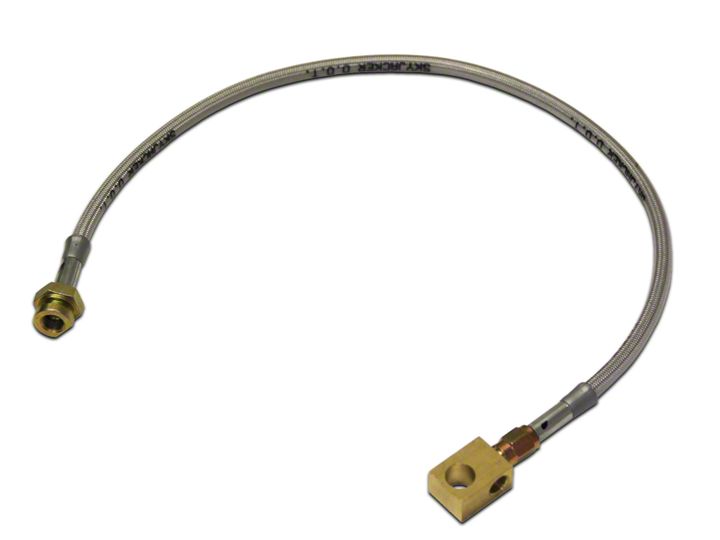

How to Install SkyJacker Rear Stainless Steel Brake Lines for 3.5-6 in. Lift (87-95 Wrangler YJ) on your Jeep Wrangler
Shop Parts in this Guide
- SkyJacker Rear Stainless Steel Brake Lines for 3.50 to 6-Inch Lift (87-95 Jeep Wrangler YJ)
- SkyJacker Rear Stainless Steel Brake Lines for 4 to 8-Inch Lift (97-06 Jeep Wrangler TJ)
- SkyJacker Front Stainless Steel Brake Lines for 3 to 8-Inch Lift (97-06 Jeep Wrangler TJ)
- SkyJacker Front Stainless Steel Brake Lines for 3.50 to 6-Inch Lift (87-95 Jeep Wrangler YJ)
Brake lines may be used on or off-road. Brake hose installation should be done by a professional mechanic. Read instructions before proceeding and follow each step completely. Bleeding the brake system should be done by two professional mechanics before driving the vehicle.
1. The new hose may or may not be an exact replica of the factory line, but the fittings are the same unless other wise stated. (See Below)
2. Remove the stock hose by using a line wrench to avoid rounding the corners. Be sure all crush washers are removed for their mating surfaces and cleaned. Inspect crush washers and replace if needed. All banjo bolts will be reused.
3. Thoroughly clean all surfaces on which the brake lines will be attached to assure a clean fit.
4. Be sure brake line fittings are tight before installing.
5. The amount of lift on the vehicle will determine if the line is too short or long. The hoses may require “tiewrapping” to a shock absorber, coil spring, vent hose or other suitable place, to prevent contact from moving objects such as tires, wheels, etc. Use the tie strap included to secure each line as necessary.
BLEEDING THE BRAKE SYSTEM:
A) Fill master cylinder with D.O.T. approved brake fluid for that manufactured vehicle.
B) Pump the brake pedal and hold down. While the pedal is down, open the bleeder nut to release air out of the system. Close or tighten nut, then let pedal up and re-pump. Continue the pumping/bleeding process, checking fluid in between pumps, until fluid is being excreted out of the bleeder nut and/or until no air is being expelled.
C) Bleed each line that has been replaced.
D) If the brake pedal will not “pump up” or have excessive down-travel if all the air is out of the system, restart at Step A.
F) It is the customer’s responsibility to check brake line for any leaks, abrasion, proper clearances, and brake line fittings after the first 100 miles and after every off-road activity.
PRODUCT USE INFORMATION:
Check any nut and/or bolt in the area for tightness. It is the customers’ responsibility to check brake lines for abrasion, leaks and/or brake line fittings for tightness after the first 100 miles and after every off-road activity.
Inspection should be done periodically by a professional mechanic to be sure everything is in proper working, functional order.
Skyjacker will not be responsible for any altered product or any improper installation or use of the product. Skyjacker does have the option to inspect any and all lines before any warranty consideration is approved.
If you have any questions concerning the product, call our main office at (318) 388-0816



